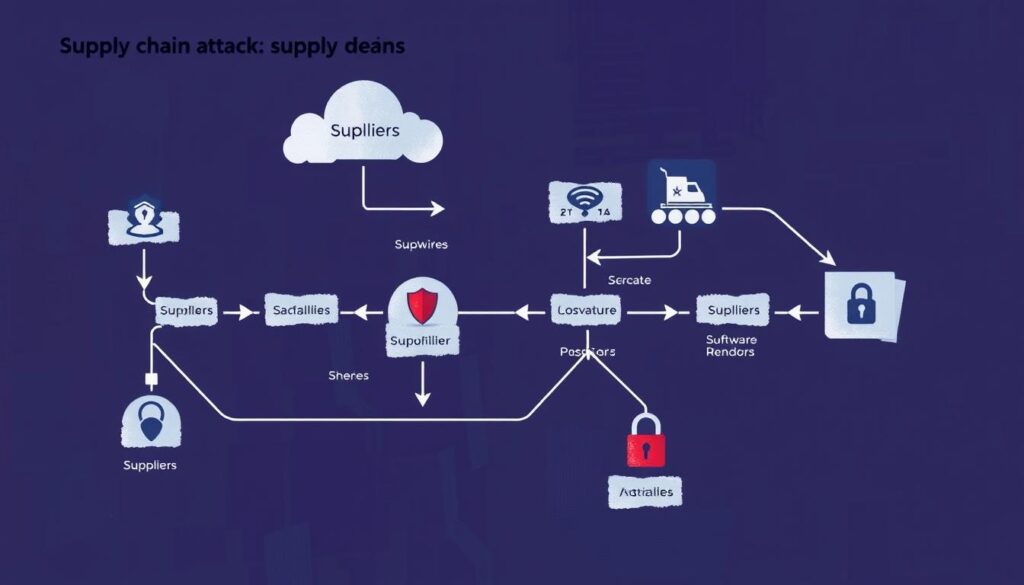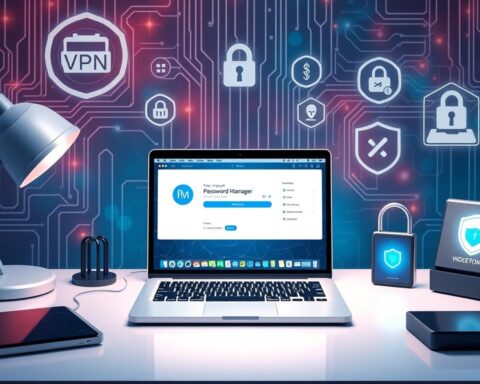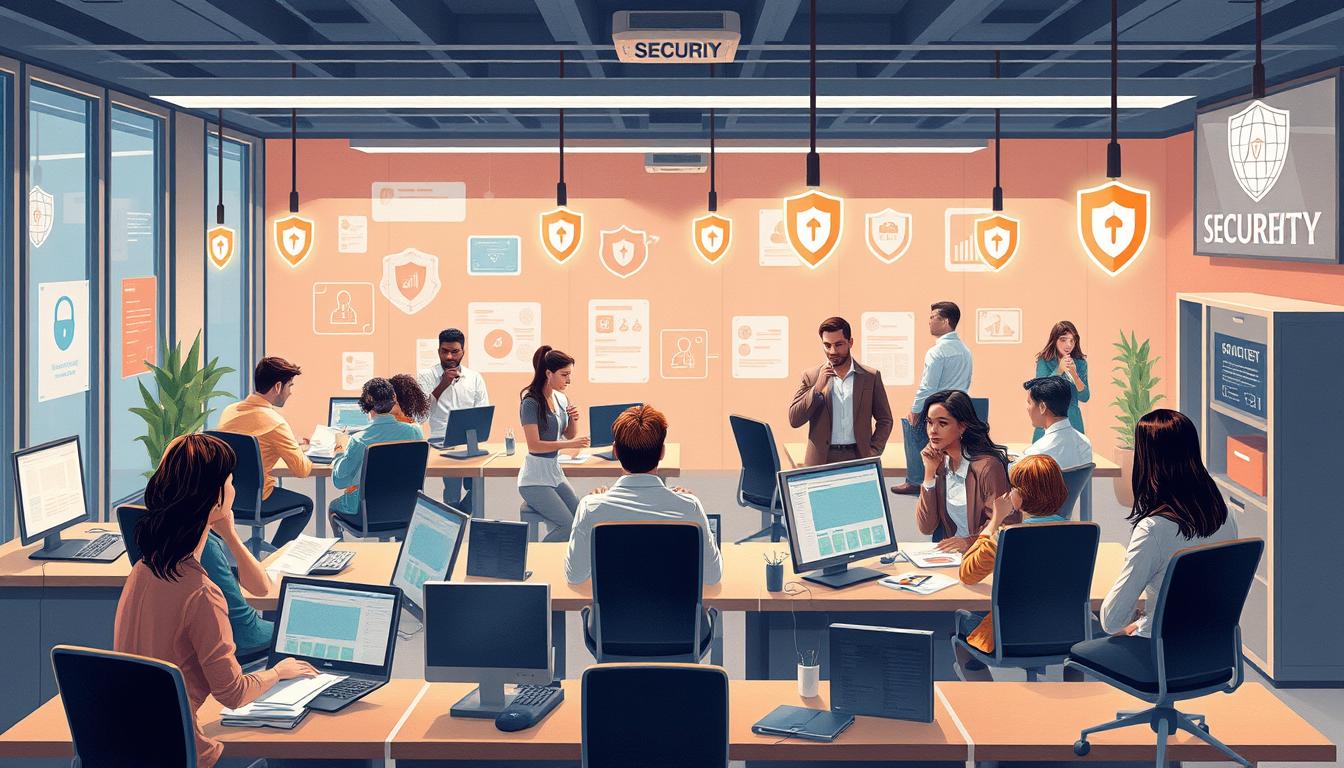Did you know a single attack in 2020 hit the networks of many U.S. government agencies and big companies1? This shows how vital supply chain security is today. In our Day 25 of Cybersecurity Training, we’ll look at how to guard against third-party risks.
Supply chain security is now a top worry for all businesses. Cybercriminals are focusing more on third-party weaknesses. So, companies must act fast to protect their stuff and data. The threats range from malware to fake parts1.
This guide will cover the basics of supply chain security. We’ll talk about common threats and how to defend against them. By learning about third and fourth-party risks, you can keep your business safe from breaches2.
Key Takeaways:
- Supply chain attacks can compromise entire networks, affecting government entities and major corporations.
- Third-party relationships expand the attack surface, requiring heightened security measures.
- Common attack vectors include malware injection, counterfeit hardware, and credential theft.
- Effective supply chain security aligns with established frameworks like NIST and ISO/IEC standards.
- Continuous monitoring and regular risk assessments are key to a secure supply chain.
Understanding Supply Chain Security Fundamentals
Supply chain security is key in today’s business world. It protects assets, information, and processes from supplier to customer. Let’s explore the main parts and challenges of this complex system.
Definition and Components of Supply Chain Security
Supply chain security guards the network of people, processes, and technologies that make and deliver products. It includes managing vendor risks and assessing third-party risks. A single weak point can open the whole network to cyber threats3.
Critical Infrastructure Dependencies
Today’s supply chains depend a lot on digital systems, making them easy targets for cyber attacks. The SolarWinds breach in 2020 showed how one weak spot can harm many4. Big companies often rely on smaller ones, which might not have strong cyber security because of budget issues4.
Modern Supply Chain Ecosystem Overview
The modern supply chain is complex and global. In 2023, software supply chain cyber attacks more than doubled from all previous years3. This rise emphasizes the need for strong security steps. Companies must look at risks up to ten layers away, making assessments harder5.
To keep supply chains safe, constant monitoring and audits are needed. Building strong vendor relationships is also key. Using Zero Trust and role-based access controls helps fight cyber threats4. Knowing these basics helps businesses safeguard their supply chains and reduce risks.
Supply Chain Security: Protecting Your Organization from Third-Party Risks
In today’s world, keeping supply chains safe is key. Companies use third-party services a lot, which makes them more vulnerable. In just three years, attacks on software supply chains have jumped by 742%6.
There are many dangers, like bad software updates and weak hardware. Also, some vendors don’t follow good security practices. Sadly, 70% of companies have been hit by third-party breaches because of too much access6. This shows we really need to check our suppliers carefully.
Nowadays, hackers are going after software tools and services more than ever before. This can lead to big problems like stolen data and ransomware attacks. These attacks can hurt thousands of people if they succeed7.
To fight these dangers, companies should take several steps:
- Cybersecurity Operations Centers (CyberSOC) for managed incident response
- Security Awareness Training to combat social engineering tactics
- Vulnerability Assessments to identify security gaps
- Managed Perimeter Security with advanced threat detection
- Penetration Testing to simulate attacks and uncover vulnerabilities
It’s important to remember that bad security at any part of the software supply chain is a big risk. Developers often use open-source parts, which can hide dangers7. By doing thorough checks on suppliers and using strong security, companies can stay safer from supply chain threats.
Common Supply Chain Attack Vectors and Vulnerabilities
Supply chain attacks are a big risk for companies. They target weak spots in the delivery network. These attacks can harm critical U.S. infrastructures and cause big data breaches8. Knowing these risks is key for keeping businesses safe and following the rules for supply chain security.
Malware Injection in Software Updates
Cybercriminals use software updates to sneak in bad code. The 3CX attack is a good example. It used fake software updates with malicious files, making it hard to spot9. This can hit many businesses at once, showing the need for strong security.
Compromised Hardware Components
Attacks on hardware can create lasting problems in a company’s systems. These issues are hard to find and can mess up everything. Using Zero Trust Architecture (ZTA) helps by treating all network traffic as a threat8.
Third-Party Data Breaches
When a vendor gets hacked, many businesses can get hit too because they share data8. The MOVEit attack affected over 620 companies, exposing personal info like addresses and IDs9. This shows why checking vendors well and keeping an eye on things is so important. Learn more about supply chain security.
Credential Theft and Access Management Risks
Attackers often go after special accounts to get into systems they shouldn’t. Companies should limit who has access to important accounts8. Using extra steps to log in can stop most cyber attacks, Microsoft says8.
To fight these threats, companies should use tools like Software Composition Analysis (SCA) and keep a Software Bill of Materials (SBOM)9. They should also use Security Information and Event Management (SIEM) systems. Adding staff training and watching for threats is a solid plan for keeping supply chains safe.
Notable Supply Chain Attack Case Studies
Supply chain attacks have skyrocketed, with a 742% jump from 2019 to 202210. This rise shows we need strong security and green supply chains. Let’s look at three big attacks that changed the cyber world.
SolarWinds Orion Breach Analysis
The SolarWinds Orion attack was a major cyber event. It hit over 18,000 companies and government groups10. This shows how blockchain could track supply chains better and catch tampering sooner.

Kaseya VSA Ransomware Attack
The Kaseya VSA ransomware hit over 1,500 firms, with ransom asks in the millions11. It showed how weak IT tools can be. It also stressed the need for better security in our supply chains.
Codecov Security Incident Impact
The Codecov breach showed dangers of hacked development tools. It’s part of a trend where attacks on key software are on the rise10.
These examples show how supply chain attacks can spread far. Experts say software supply chain breaches could cost $138 billion a year by 203111. Using blockchain and green supply chains are key to fighting these threats.
Implementing Third-Party Risk Management (TPRM)
In today’s world, having a strong Third-Party Risk Management (TPRM) program is key for vendor risk management. With 60% of data breaches caused by third-party vendors, companies face big challenges in keeping their supply chains safe12.
To start a good TPRM program, first make a detailed list of all third-party suppliers and vendors. This step helps find out who is most important and who has access to sensitive information. Then, give them risk ratings based on how critical they are and what access they have. This helps focus security efforts where they are most needed.
Companies that manage their third-party risks well can cut down on vulnerabilities a lot. In fact, good TPRM programs can lower the chance of big problems by up to 75%12.
Key Components of TPRM
- Risk assessment
- Due diligence
- Ongoing monitoring
- Compliance maintenance
It’s important to keep an eye on vendors all the time to stop big problems before they start13. This is very important because third-party vendors often get into our systems and see our sensitive data14.
Having a TPRM plan helps hold everyone accountable and makes a company stronger against outside threats13. With third-party data breaches costing an average of $4.55 million, ignoring TPRM can be very costly14.
| TPRM Benefits | Statistics |
|---|---|
| Reduced Risk of Disruptions | Up to 75% reduction |
| Financial Impact Mitigation | $4.55 million average cost avoided |
| Improved Risk Visibility | 83% of organizations report enhanced capabilities |
As more businesses use third-party vendors, having a solid TPRM program is more important than ever. It helps keep operations running smoothly and in line with rules. By focusing on third-party risk and using strong security measures, companies can handle the complex world of vendors with confidence.
Essential Security Controls for Supply Chain Protection
Securing supply chains is key in today’s world. Digital supply chains are getting more complex. This means we need strong cybersecurity measures to protect our operations and data.
Vendor Assessment Protocols
It’s important to check your suppliers’ security regularly. Companies should do audits and ask for security reviews to find new threats15. This way, we can spot and fix weak spots in the supply chain before they’re used against us.
Security Contract Requirements
When making contracts with suppliers, include cybersecurity best practices. Make sure they agree to certain risk levels and how to report breaches15. Also, make sure they’re part of your disaster plans16. This keeps everyone on the same page when it comes to security.
Continuous Monitoring Solutions
It’s vital to keep an eye on your supply chain all the time. Use tools like live monitoring and smart tags to track your products and assets16. This way, you can spot and deal with security threats fast.
Use role-based access control (RBAC) to reduce attack risks. Also, adopt a zero-trust model to check who has access to what16. Regular tests can find and fix security holes, making your supply chain safer16.
By using these security controls, businesses can protect their supply chains better. Remember, keeping your supply chain safe is an ongoing task. It needs constant effort and updates to stay ahead of new threats.
Building a Resilient Supply Chain Strategy
In today’s world, having a strong supply chain is key for keeping businesses running. A Gartner survey found that only 21% of companies have a very resilient supply chain. More than half want to get there in a few years17. This shows how important it is for companies to make their supply chains stronger.
Risk Assessment Frameworks
The NIST Special Publication 800-161 provides a detailed plan for managing cyber risks in supply chains. It helps companies spot, check, and lower risks in IT/OT products and services. Using this plan can greatly improve supply chain security and resilience.
Supplier Diversity Planning
It’s important to have different suppliers to lower risks. Many retailers are moving from using just one supplier to using many17. This way, they don’t rely on just one supplier and have backup plans if something goes wrong.
Incident Response Coordination
Creating a disaster recovery plan with vendors is critical for keeping businesses going17. This plan should have clear ways to communicate and steps for handling security issues. Keeping anti-virus and firewall software up to date is also key for managing cyber risks17.
| Strategy | Benefits | Challenges |
|---|---|---|
| Risk Assessment | Identifies vulnerabilities | Requires ongoing monitoring |
| Supplier Diversity | Reduces single-source dependency | May increase costs |
| Incident Response | Improves recovery time | Needs regular updates and testing |
By using these strategies, companies can make their supply chains strong and ready for any problem. This forward-thinking is essential for keeping businesses running smoothly in a changing world.
Regulatory Compliance and Standards
In today’s complex business world, following supply chain regulations is key. Companies face big challenges in keeping their supply chains safe and meeting strict rules. The U.S. National Counterintelligence Strategy for 2020-2022 aims to lessen threats to key U.S. supply chains, showing how important this is18.
The problem is huge. On average, a company shares secret info with 583 third-party vendors. And 82% of companies give these vendors access to sensitive data19. This makes it vital to have strong rules and standards to protect against these risks.
To fight these dangers, companies are using third-party risk management (TPRM) policies. These policies help spot, track, lessen, and report risks from vendors and partners. A good TPRM policy could cut data breaches by 50%20.
New tech like blockchain for tracking supply chains is becoming more popular. Blockchain’s unchangeable ledger makes it easy to track products and deals in the supply chain.
Important rules for supply chain safety include CCPA, GDPR, HIPAA, and PCI DSS. If companies don’t follow these rules, they could face fines of up to 10% of their income20. To stay compliant, 90% of companies do deep checks before sharing sensitive info with others20.
The ISO/IEC 27001:2022 standard is a global guide for keeping information safe. Following this standard helps manage information security risks in the supply chain.
By following these rules and standards, companies can boost their security and show they follow best practices in supply chain management. This is critical in today’s world where supply chain risks can affect many.
Conclusion
Protecting your organization from third-party risks is now more important than ever. The number of supply chain attacks has doubled in the last two years21. The MOVEit cyber-attack, affecting over 2,000 organizations and 60 million people, shows the damage that can happen22.
To keep your business safe, focus on vetting suppliers and managing third-party risks well. This means doing deep background checks on suppliers and checking their security measures21. It’s also important to have clear contracts and strict security rules in your supply chain23.
Training your employees is also key. Teaching them to spot and handle threats can help protect your business23. Using the latest technology and tools can help detect and prevent attacks early on23.
In short, supply chain security is not just about defense; it’s a strategic move. By taking these steps, you can make your business more resilient and keep your customers’ trust. Always be ready to adapt and improve to stay ahead of threats.
FAQ
What is supply chain security and why is it important?
How can organizations effectively assess and manage vendor risks?
What are some common supply chain attack vectors?
How can organizations build resilience against supply chain attacks?
What role does regulatory compliance play in supply chain security?
How can emerging technologies like blockchain enhance supply chain security?
What are the key components of an effective incident response plan for supply chain security?
How can organizations ensure the security of software updates in their supply chain?
Source Links
- Day 8: Supply Chain Attacks — Protecting Your Organization from Third-Party Risks. – https://medium.com/@wilklins/day-8-supply-chain-attacks-protecting-your-organization-from-third-party-risks-b30ac00b54ec
- Cyber Supply Chain Security and Third-Party Risk Management – https://www.bankinfosecurity.com/blogs/cyber-supply-chain-security-third-party-risk-management-p-3680
- The Importance of Supply Chain Cybersecurity – https://online.utulsa.edu/blog/supply-chain-cybersecurity/
- Strengthening supply chains: Start with Cyber security fundamentals – https://insights.integrity360.com/strengthening-supply-chains-start-with-cyber-security-fundamentals
- Understanding and Managing Supply Chain Risk (with Michael Caruso) – https://www.accesspointconsulting.com/state-of-security-videos/understanding-and-managing-supply-chain-risk-with-michael-caruso
- Supply Chain Security: Protecting Manufacturers from Third-Party Risks – https://www.usclaro.com/blog/supply-chain-security-protecting-manufacturers-from-third-party-risks
- Protecting your organization from software supply chain threats – ITSM.10.071 – Canadian Centre for Cyber Security – https://www.cyber.gc.ca/en/guidance/protecting-your-organization-software-supply-chain-threats-itsm10071
- 11 Ways to Prevent Supply Chain Attacks in 2025 (Highly Effective) | UpGuard – https://www.upguard.com/blog/how-to-prevent-supply-chain-attacks
- Software Supply Chain Attacks: Attack Vectors, Examples, and 6 Defensive Measures – https://www.exabeam.com/explainers/information-security/software-supply-chain-attacks-attack-vectors-examples-and-6-defensive-measures/
- Top 10 Supply Chain Attacks that Shook the World – https://www.encryptionconsulting.com/top-10-supply-chain-attacks-that-shook-the-world/
- Notable Supply Chain Compromise Attacks and Defenses – https://xygeni.io/blog/notable-supply-chain-compromise-attacks-and-defenses/
- A Guide to Third-Party Risk Management in Supply Chains – https://veriforce.com/blog/a-guide-to-third-party-risk-management-in-supply-chains
- Complete Third-Party Risk Management (TPRM) Guide for 2025 – https://securityscorecard.com/blog/complete-third-party-risk-management-guide/
- What Is Third-Party Risk Management (TPRM)? 2025 Guide | UpGuard – https://www.upguard.com/blog/third-party-risk-management
- Digital Supply Chain Security Best Practices & Cyber Risk Management – https://business.bofa.com/en-us/content/digital-supply-chain-security.html
- 7 Key Supply Chain Security Best Practices – https://www.nri-secure.com/blog/supply-chain-security-best-practices
- Supply Chain Risk Management: 10 Strategies for Success – Hitachi Solutions – https://global.hitachi-solutions.com/blog/supply-chain-risk-management/
- Supply Chain Risk Management (SCRM) – https://ncua.gov/regulation-supervision/regulatory-compliance-resources/cybersecurity-resources/supply-chain-risk-management-scrm
- Third-Party Security: 8 Steps To Assessing Risks And Protecting Your Ecosystem – https://secureframe.com/blog/third-party-security
- Third-Party Vendor Risk Management Policies: Best Practices | Prevalent – https://www.prevalent.net/blog/third-party-vendor-risk-management-policy/
- How to Protect Your Supply Chain From Third-Party Cyber Risk | GEP Blogs – https://www.gep.com/blog/strategy/third-party-cyber-risk-how-to-protect-your-supply-chain-from-the-next-breach
- Securing your organization’s supply chain: Reducing the risks of third parties – Help Net Security – https://www.helpnetsecurity.com/2024/05/02/supply-chain-third-parties-risks/
- Shield Your Business: Mitigate Third-Party Risks & Prevent Supply Chain Attacks – https://www.linkedin.com/pulse/impact-supply-chain-attacks-how-mitigate-third-party-risks-kakkerla-leryc







